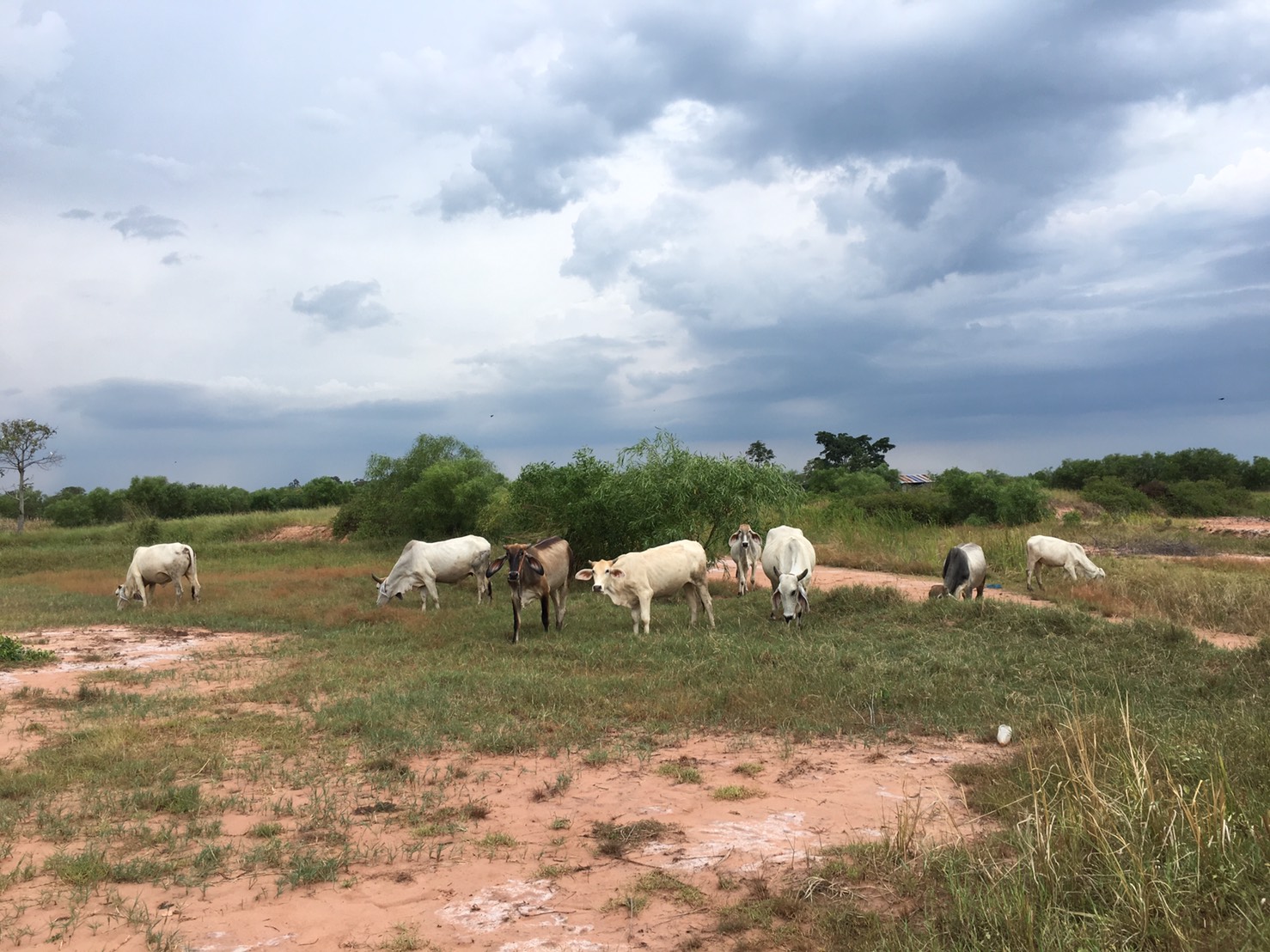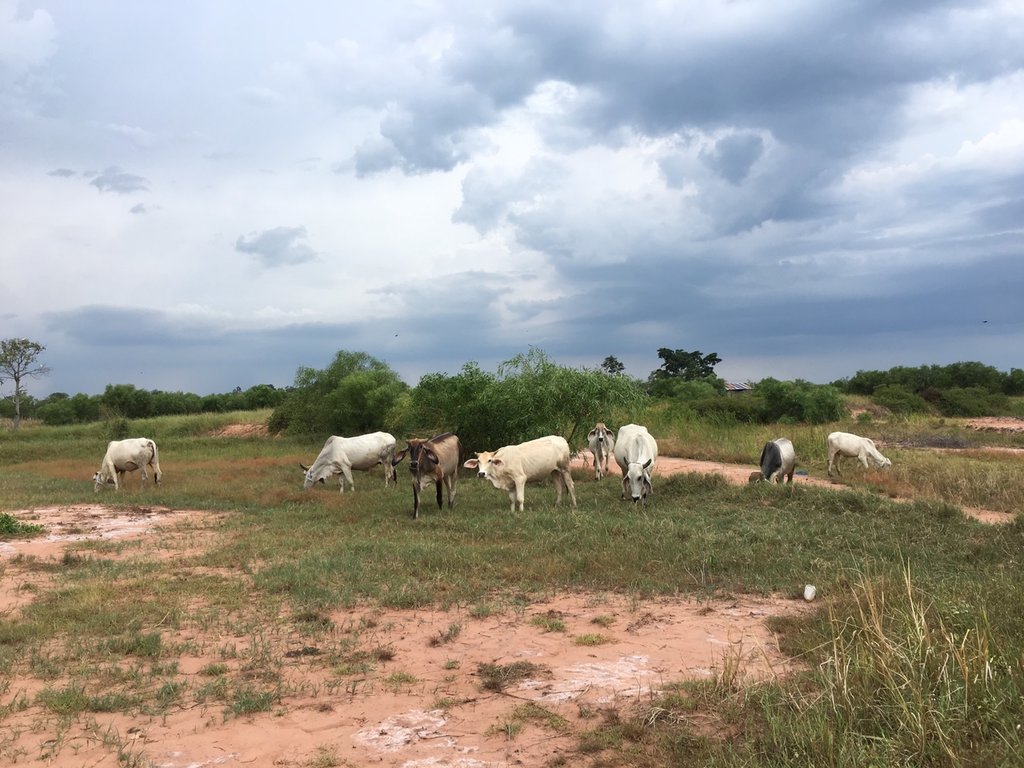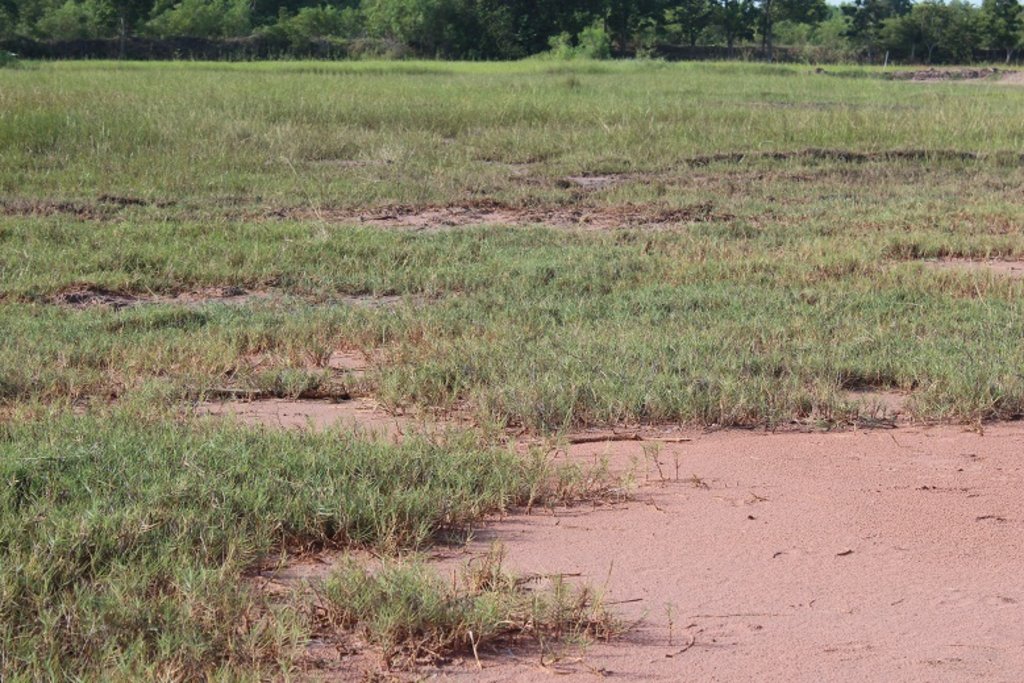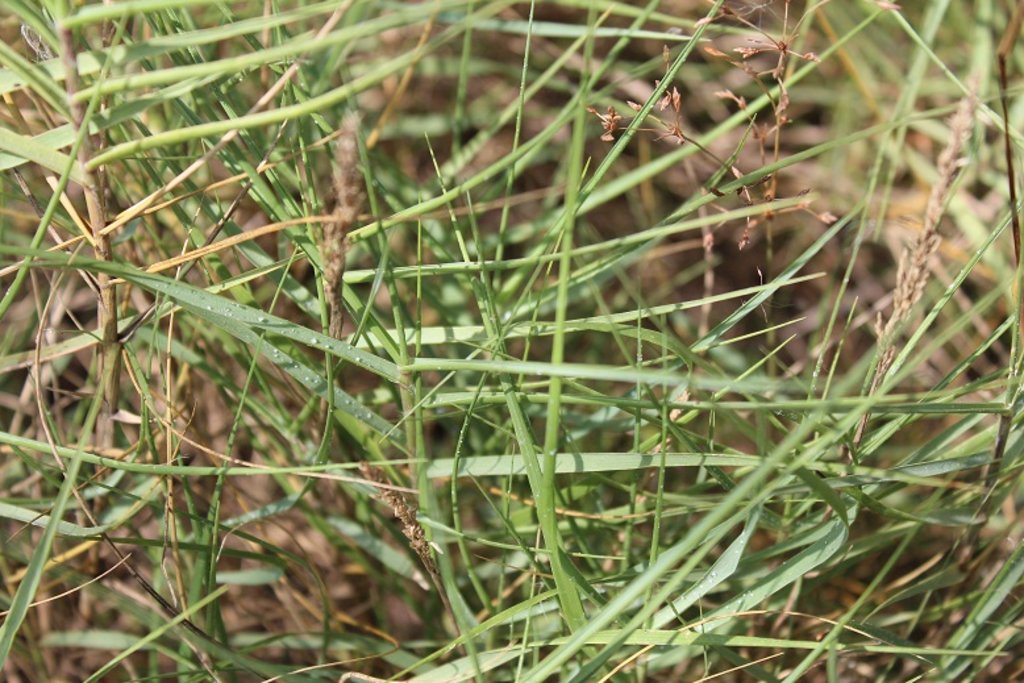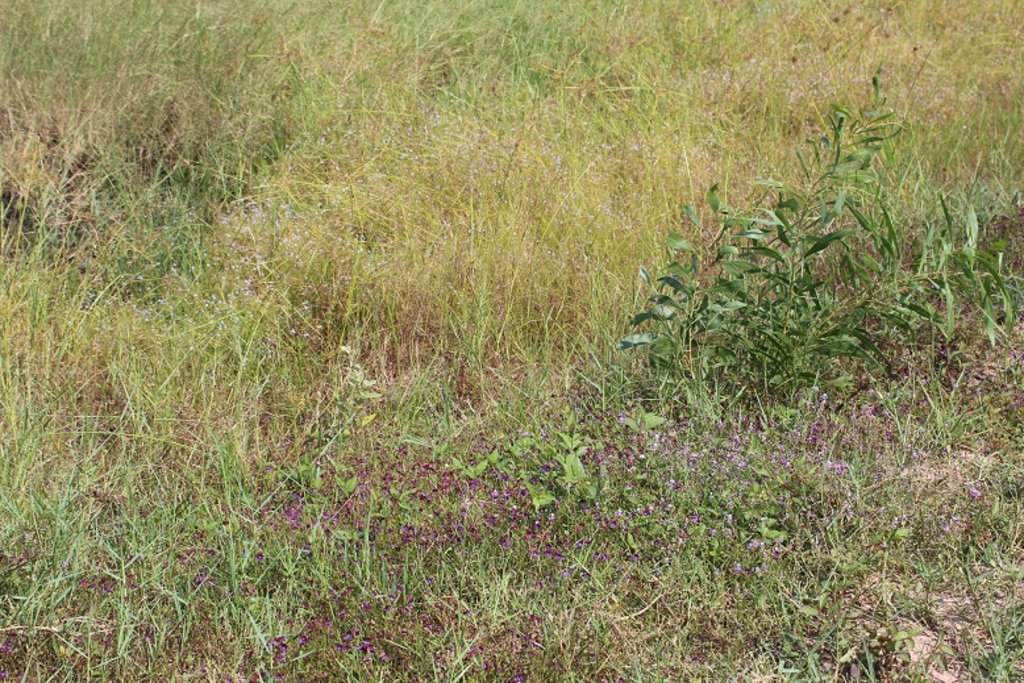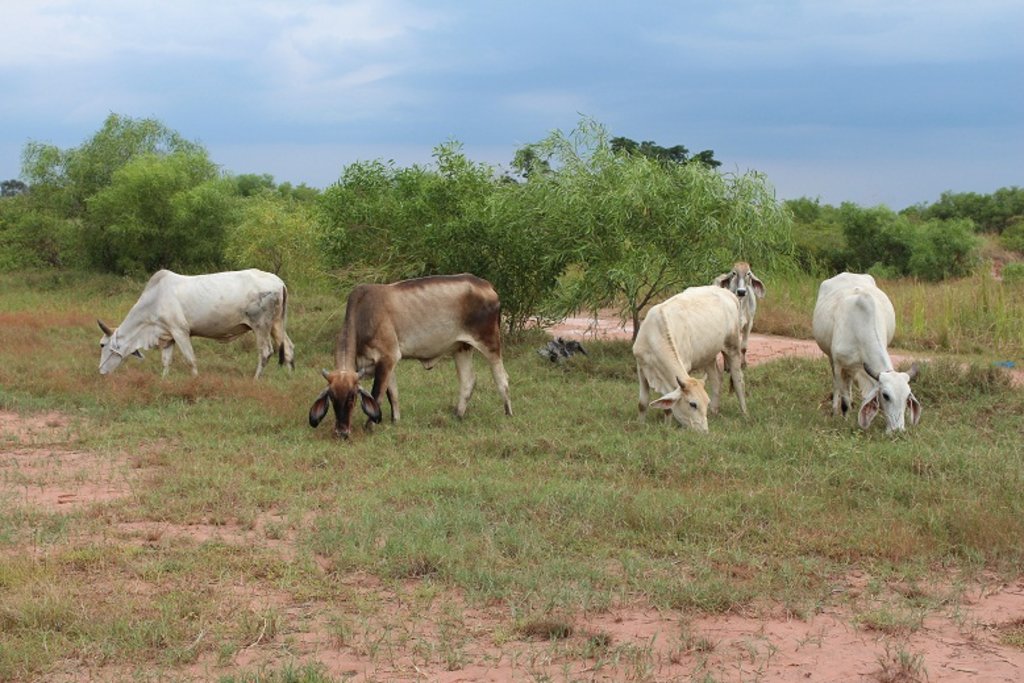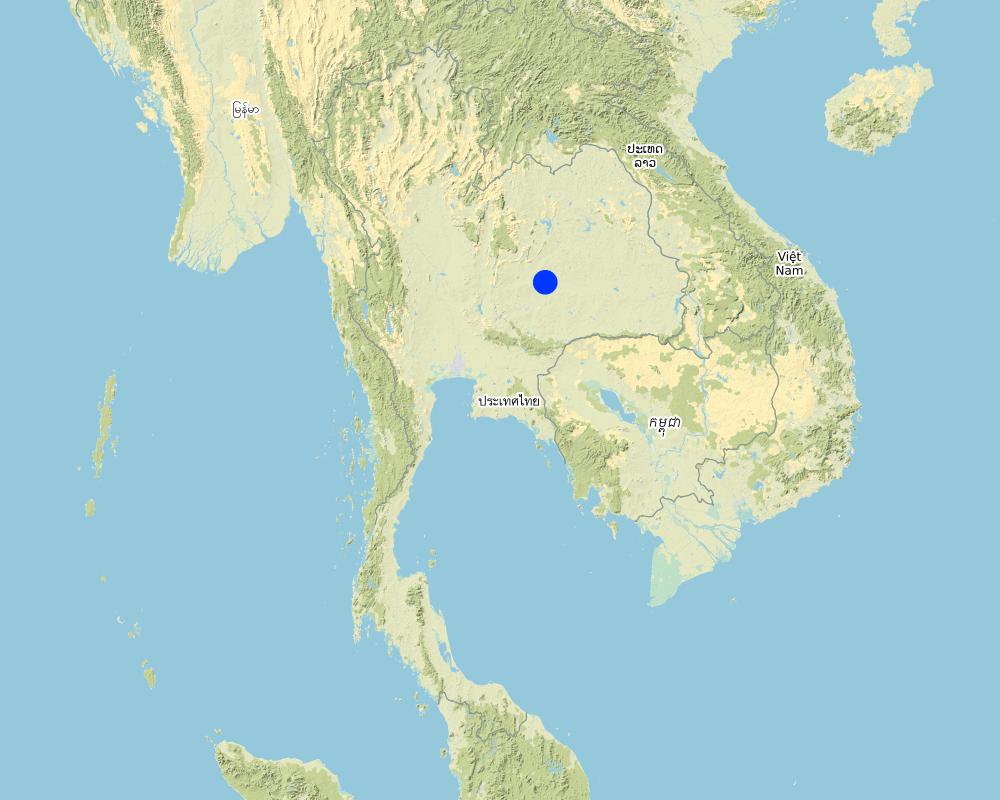Planting a Halophyte (Sporobolus virginicus, "Dixie grass") to rehabilitate severely saline soil. [Thailand]
- Creation:
- Update:
- Compiler: Kamontip Sasithorn
- Editor: –
- Reviewers: Rima Mekdaschi Studer, William Critchley
Planting Dixie grass in severely saline soil.
technologies_4158 - Thailand
View sections
Expand all Collapse all1. General information
1.2 Contact details of resource persons and institutions involved in the assessment and documentation of the Technology
Key resource person(s)
land user:
Munkarn Charong
6 Bann Donpae Moo 8 Kut Chok Sub-district Bua Yai District Nakhon Ratchasima Province.
Thailand
SLM specialist:
SLM specialist:
SLM specialist:
SLM specialist:
National Consultants:
Name of project which facilitated the documentation/ evaluation of the Technology (if relevant)
Book project: where people and their land are safer - A Compendium of Good Practices in Disaster Risk Reduction (DRR) (where people and their land are safer)Name of project which facilitated the documentation/ evaluation of the Technology (if relevant)
Book project: where the land is greener - Case Studies and Analysis of Soil and Water Conservation Initiatives Worldwide (where the land is greener) {'additional_translations': {}, 'value': 79, 'label': 'Name of the institution(s) which facilitated the documentation/ evaluation of the Technology (if relevant)', 'text': 'Land Development Department LDD (Land Development Department LDD) - Thailand', 'template': 'raw'}1.3 Conditions regarding the use of data documented through WOCAT
The compiler and key resource person(s) accept the conditions regarding the use of data documented through WOCAT:
Yes
1.4 Declaration on sustainability of the described Technology
Is the Technology described here problematic with regard to land degradation, so that it cannot be declared a sustainable land management technology?
No
Comments:
The technology is very well accepted by the land users.
1.5 Reference to Questionnaire(s) on SLM Approaches (documented using WOCAT)
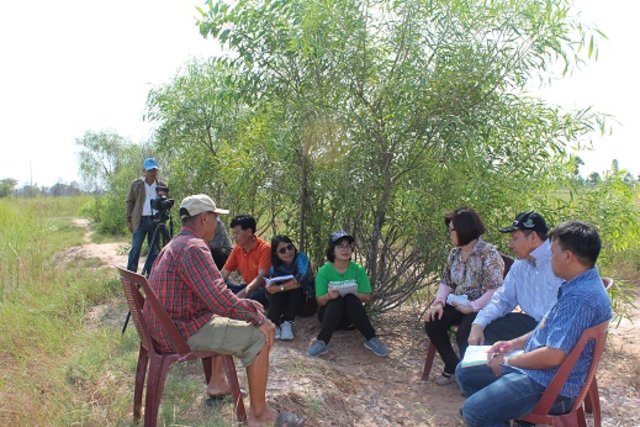
Vegetative approach of using a halophyte ("Dixie grass", … [Thailand]
The government promotes a halophyte (Dixie grass) to control severely salt-affected land, rehabilitate the ecosystem and prevent the spread of salt in soil - with the cooperation of land owners, livestock farmers, the local administration, the local government agency, Land Development Department researchers and with specialists/ technical advisors in various …
- Compiler: Kamontip Sasithorn
2. Description of the SLM Technology
2.1 Short description of the Technology
Definition of the Technology:
Planting a halophyte - Dixie grass (Sporobolus verginicus) - aims to increase the area of land usable by farmers and to prevent expansion of severely saline soils. Dixie grass can be utilised as cattle feed. The Land Development Department has been involved in developing and disseminating this technology.
2.2 Detailed description of the Technology
Description:
The Land Development Department (LDD) transfered the technology of planting a halophyte (Sporobolus virginicus: "Dixie grass") for the rehabilitation of severely saline soil to Mr.Charong Munkarn’s land in Buayai district, Nakhonratchasima province. The area is on a 0-2% slope, demonstrates high soil electrical conductivity and is classified as a severely saline soil. The land is salt crusted and barren. The climate is semi -arid, and rainfall is between 750 and 1,000 millimeters per year. The exotic halophyte, namely Sporobolus virginicus, (Dixie grass) is adapted to survive in severely salt- affected soil. The mechanisms of its tolerance includes osmotic adjustment within the plant, salt exclusion, ion accumulation and sequestration, and excretion of salt via glands in the plant’s leafs and stem. The benefits of planting this halophyte on such a severely saline soil are soil moisture conservation, salt accumulation prevention on the surface, and utilization as feed for livestock. The objectives of the technology are to 1) prevent expansion of severely saline soil, 2) maximize use of land for farmers, 3) use halophyte grasses as cover crop for rehabilitation of the ecosystem of severely salt-affected soil. Halophyte plantation has been supported by Land Development Department under the project: Promotion of Integrated Saline Soil Management. The stakeholders are researchers of LDD who have worked together with community volunteers, community leaders and farmers on soil improvement. The Land Development Regional Office 3 (Nakhonratchasima) supported Dixie grass planting material production, together with provision of compost and chemical fertilizer. Dixie grass cuttings (stolons) were planted at spacing of 20 x 20 centimeters on abandoned areas and on ridges between rows of Acacia ampliceps. After 3 years of planting Dixie grass, it has been found that this barren land was covered by plants and much improved in biodiversity by the evidence of many varieties of wild grass, dragonflies, small mammels and birds. Farmers can grow rice and they use Dixie grass as feed for livestock. Moreover farmers are able to increased their incomes. Migration for jobs to big cities has been reduced. Interviews showed that farmers are satisfied with this technology. Besides being lower in salinity (observed, and measured by scientists), farmers get better rice yields, and an improved environment and livelihoods. Although the planting of halophytes is an improvement to severely saline soil with low costs, the recovery time of saline soil is not as fast as that of engineering measure with higher investment. Furthermore, neighboring farmers often burn their rice straw after harvesting, and that damages the Dixie grass.
2.3 Photos of the Technology
2.4 Videos of the Technology
Comments, short description:
To interview Mr. Charong Munkarn on the use of Dixie grass for rehabilitation severely saline soil.
Date:
18/10/2018
Location:
6 Bann Donpae Moo 8 Kut Chok Sub-district Bua Yai District Nakhon Ratchasima Province.
Name of videographer:
Kamonthip Sasithorn
2.5 Country/ region/ locations where the Technology has been applied and which are covered by this assessment
Country:
Thailand
Region/ State/ Province:
6 Bann Donpae Moo 8 Kut Chok Sub-district Bua Yai District Nakhon Ratchasima Province.
Further specification of location:
Bann Donpae
Specify the spread of the Technology:
- applied at specific points/ concentrated on a small area
Is/are the technology site(s) located in a permanently protected area?
No
Comments:
The SLM technology site for planting the halophyte Sporobolus virginicus (Dixie grass) to rehabilitate severely saline soil
Map
×2.6 Date of implementation
Indicate year of implementation:
2015
If precise year is not known, indicate approximate date:
- less than 10 years ago (recently)
2.7 Introduction of the Technology
Specify how the Technology was introduced:
- through projects/ external interventions
Comments (type of project, etc.):
Soil management on sub-watershed area, activity of rehabilitation severely salt-affected soil by planting salt tolerant trees and grass.
3. Classification of the SLM Technology
3.1 Main purpose(s) of the Technology
- reduce, prevent, restore land degradation
- conserve ecosystem
- preserve/ improve biodiversity
3.2 Current land use type(s) where the Technology is applied
Land use mixed within the same land unit:
Yes
Specify mixed land use (crops/ grazing/ trees):
- Agro-pastoralism (incl. integrated crop-livestock)

Other
Specify:
Extremely salt affected areas
Remarks:
Extremely salt affected areas that can not used for agricultural land.
Comments:
Saline soil areas should be rehabilitated using low investment technology by planting highly adapted salt tolerant species such as Dixie grass.
3.3 Has land use changed due to the implementation of the Technology?
Has land use changed due to the implementation of the Technology?
- Yes (Please fill out the questions below with regard to the land use before implementation of the Technology)
Land use mixed within the same land unit:
Yes
Specify mixed land use (crops/ grazing/ trees):
- Agro-pastoralism (incl. integrated crop-livestock)

Grazing land
Extensive grazing:
- Semi-nomadic pastoralism
Intensive grazing/ fodder production:
- Improved pastures
Animal type:
- livestock - other small
Is integrated crop-livestock management practiced?
No
Products and services:
- meat
Count:
1
3.4 Water supply
Water supply for the land on which the Technology is applied:
- rainfed
Comments:
Grass planting area by farmers is outside the irrigated area.
3.5 SLM group to which the Technology belongs
- pastoralism and grazing land management
- improved ground/ vegetation cover
- ecosystem-based disaster risk reduction
3.6 SLM measures comprising the Technology

vegetative measures
- V2: Grasses and perennial herbaceous plants
- V5: Others
3.7 Main types of land degradation addressed by the Technology

chemical soil deterioration
- Cs: salinization/ alkalinization
3.8 Prevention, reduction, or restoration of land degradation
Specify the goal of the Technology with regard to land degradation:
- prevent land degradation
- restore/ rehabilitate severely degraded land
Comments:
Dixie is planted to prevent the spread of salt in the area.
4. Technical specifications, implementation activities, inputs, and costs
4.1 Technical drawing of the Technology
Technical specifications (related to technical drawing):
(a) Propagation of Dixie grass through shoot (stolon) cuttings of 2-3 inches long with
3 nodes is made and planted in bags filled with soil and compost. The seedling
is 1 month old before planting in the pit of 10x10x10 cubic cm. with 200 gm. of
compost and 6.25 gm of 15-15-15 chemical fertilizer then cover with rice husk
at 400 gm/pit, the spacing between pits is 30x30 square cm.
(b) A sketch of planting Dixie grasses on severely salt affected land with
Acacia ampliceps on the ridges. After 3 years of planting, Dixie grass
has been replaced by rice except those on the ridge.
Author:
Winai Chombut
Date:
18/10/2018
4.2 General information regarding the calculation of inputs and costs
Specify how costs and inputs were calculated:
- per Technology area
other/ national currency (specify):
Baht
If relevant, indicate exchange rate from USD to local currency (e.g. 1 USD = 79.9 Brazilian Real): 1 USD =:
32.0
Indicate average wage cost of hired labour per day:
300
4.3 Establishment activities
| Activity | Timing (season) | |
|---|---|---|
| 1. | Dixie grass nursery | May-July 2015 |
| 2. | Land preparation for planting | May-July 2015 |
| 3. | Fertilizer application | May-July 2015 |
4.4 Costs and inputs needed for establishment
| Specify input | Unit | Quantity | Costs per Unit | Total costs per input | % of costs borne by land users | |
|---|---|---|---|---|---|---|
| Labour | Labor cost for planting Eucalyptus (labor wage per day = 300 baht, 1 rai required to labor cost = 1200 baht) | Rai | 1.0 | 1200.0 | 1200.0 | |
| Plant material | Dixie seedling cost 1600 trees/rai, 1 baht for each seedling | seedling | 1600.0 | 0.5 | 800.0 | |
| Fertilizers and biocides | Compost cost 3.5 baht/kg, 0.2 kg/pit | kg | 320.0 | 3.5 | 1120.0 | |
| Fertilizers and biocides | Rice husk cost 4 baht/kg, 0.4 kg/pit | kg | 640.0 | 4.0 | 2560.0 | |
| Fertilizers and biocides | Chemical fertilizer 15-15-15 cost 20 baht/kg, 6.25 kg/pit | kg | 10.0 | 20.0 | 200.0 | |
| Total costs for establishment of the Technology | 5880.0 | |||||
| Total costs for establishment of the Technology in USD | 183.75 | |||||
If land user bore less than 100% of costs, indicate who covered the remaining costs:
Land Development Department
Comments:
Labor cost for land preparation, planting and seedlings covered by LDD Chemical fertilizer 15-15-15; compost and rice husks are from farm by-products.
4.5 Maintenance/ recurrent activities
| Activity | Timing/ frequency | |
|---|---|---|
| 1. | No maintenance activities because Dixies grasses can glow well and be multiplied extensively by themselves |
4.6 Costs and inputs needed for maintenance/ recurrent activities (per year)
| Specify input | Unit | Quantity | Costs per Unit | Total costs per input | % of costs borne by land users | |
|---|---|---|---|---|---|---|
| Labour | No labor cost for maintenance | 0 |
4.7 Most important factors affecting the costs
Describe the most determinate factors affecting the costs:
The government policy on minimum labor wage is an important factor affected cost of the project.
5. Natural and human environment
5.1 Climate
Annual rainfall
- < 250 mm
- 251-500 mm
- 501-750 mm
- 751-1,000 mm
- 1,001-1,500 mm
- 1,501-2,000 mm
- 2,001-3,000 mm
- 3,001-4,000 mm
- > 4,000 mm
Specify average annual rainfall (if known), in mm:
1028.00
Specifications/ comments on rainfall:
Average annual rainfall from 1983-2012
Indicate the name of the reference meteorological station considered:
Meteorological Department
Agro-climatic zone
- semi-arid
Average temperature 21 - 36 degree Celsius, relative humidity is 75%
5.2 Topography
Slopes on average:
- flat (0-2%)
- gentle (3-5%)
- moderate (6-10%)
- rolling (11-15%)
- hilly (16-30%)
- steep (31-60%)
- very steep (>60%)
Landforms:
- plateau/plains
- ridges
- mountain slopes
- hill slopes
- footslopes
- valley floors
Altitudinal zone:
- 0-100 m a.s.l.
- 101-500 m a.s.l.
- 501-1,000 m a.s.l.
- 1,001-1,500 m a.s.l.
- 1,501-2,000 m a.s.l.
- 2,001-2,500 m a.s.l.
- 2,501-3,000 m a.s.l.
- 3,001-4,000 m a.s.l.
- > 4,000 m a.s.l.
Indicate if the Technology is specifically applied in:
- not relevant
Comments and further specifications on topography:
The geography is that of the lower basin of Korat plateau in the Northeast Thailand
5.3 Soils
Soil depth on average:
- very shallow (0-20 cm)
- shallow (21-50 cm)
- moderately deep (51-80 cm)
- deep (81-120 cm)
- very deep (> 120 cm)
Soil texture (topsoil):
- coarse/ light (sandy)
Soil texture (> 20 cm below surface):
- medium (loamy, silty)
Topsoil organic matter:
- low (<1%)
If available, attach full soil description or specify the available information, e.g. soil type, soil PH/ acidity, Cation Exchange Capacity, nitrogen, salinity etc.
Texture of top soil is fine loamy and more than 20 cm below the surface is sandy loam or sandy clay loam, pH = 7 and increasing with depth up to 8.5, salinity is moderately to highly soil affected identified by percentage of the salt crust on the surface, very low P and K.
5.4 Water availability and quality
Ground water table:
< 5 m
Is water salinity a problem?
Yes
Specify:
Slightly saline
Is flooding of the area occurring?
No
Comments and further specifications on water quality and quantity:
Shallow saline groundwater exists because of low lying discharge area and salt source beneath under the ground.
5.5 Biodiversity
Species diversity:
- low
Habitat diversity:
- low
Comments and further specifications on biodiversity:
Before planting Dixie grass, species richness was low and the habitat was poor. After 3 years, field crabs, field rats, dragonflies, earthworms, weasels, snakes, local weeds and wildflowers which had disappeared are now found again.
5.6 Characteristics of land users applying the Technology
Sedentary or nomadic:
- Sedentary
Market orientation of production system:
- mixed (subsistence/ commercial)
Off-farm income:
- 10-50% of all income
Relative level of wealth:
- average
Individuals or groups:
- individual/ household
Level of mechanization:
- manual work
Gender:
- men
Age of land users:
- middle-aged
Indicate other relevant characteristics of the land users:
Diligent farmers seeking more income burn firewood from Acacia tree, catch field rats and harvest bamboo shoots.
5.7 Average area of land used by land users applying the Technology
- < 0.5 ha
- 0.5-1 ha
- 1-2 ha
- 2-5 ha
- 5-15 ha
- 15-50 ha
- 50-100 ha
- 100-500 ha
- 500-1,000 ha
- 1,000-10,000 ha
- > 10,000 ha
Is this considered small-, medium- or large-scale (referring to local context)?
- small-scale
Comments:
Farmers have been planting Dixie grass together with Acacia trees on rice bunds and make charcoal from Acacia trees
in order to get additional income.
5.8 Land ownership, land use rights, and water use rights
Land ownership:
- individual, titled
Land use rights:
- individual
- Rainfed
5.9 Access to services and infrastructure
health:
- poor
- moderate
- good
education:
- poor
- moderate
- good
technical assistance:
- poor
- moderate
- good
employment (e.g. off-farm):
- poor
- moderate
- good
markets:
- poor
- moderate
- good
energy:
- poor
- moderate
- good
roads and transport:
- poor
- moderate
- good
drinking water and sanitation:
- poor
- moderate
- good
financial services:
- poor
- moderate
- good
6. Impacts and concluding statements
6.1 On-site impacts the Technology has shown
Socio-economic impacts
Production
crop production
crop quality
fodder production
risk of production failure
production area
land management
Water availability and quality
drinking water availability
drinking water quality
water availability for livestock
water quality for livestock
irrigation water availability
irrigation water quality
demand for irrigation water
Income and costs
expenses on agricultural inputs
farm income
diversity of income sources
workload
Socio-cultural impacts
food security/ self-sufficiency
health situation
land use/ water rights
cultural opportunities
community institutions
national institutions
SLM/ land degradation knowledge
conflict mitigation
situation of socially and economically disadvantaged groups
Ecological impacts
Water cycle/ runoff
water quantity
water quality
harvesting/ collection of water
surface runoff
excess water drainage
groundwater table/ aquifer
evaporation
Soil
soil moisture
soil cover
soil loss
soil accumulation
soil crusting/ sealing
soil compaction
nutrient cycling/ recharge
salinity
soil organic matter/ below ground C
acidity
Biodiversity: vegetation, animals
Vegetation cover
biomass/ above ground C
plant diversity
invasive alien species
animal diversity
beneficial species
habitat diversity
pest/ disease control
Climate and disaster risk reduction
flood impacts
landslides/ debris flows
drought impacts
impacts of cyclones, rain storms
emission of carbon and greenhouse gases
fire risk
wind velocity
micro-climate
6.2 Off-site impacts the Technology has shown
water availability
reliable and stable stream flows in dry season
downstream flooding
downstream siltation
groundwater/ river pollution
buffering/ filtering capacity
wind transported sediments
damage on neighbours' fields
damage on public/ private infrastructure
impact of greenhouse gases
6.3 Exposure and sensitivity of the Technology to gradual climate change and climate-related extremes/ disasters (as perceived by land users)
Climate-related extremes (disasters)
Climatological disasters
| How does the Technology cope with it? | |
|---|---|
| drought | not well |
| forest fire | moderately |
| land fire | moderately |
Hydrological disasters
| How does the Technology cope with it? | |
|---|---|
| flash flood | moderately |
Biological disasters
| How does the Technology cope with it? | |
|---|---|
| insect/ worm infestation | moderately |
Other climate-related consequences
Other climate-related consequences
| How does the Technology cope with it? | |
|---|---|
| extended growing period | not well |
| reduced growing period | not well |
6.4 Cost-benefit analysis
How do the benefits compare with the establishment costs (from land users’ perspective)?
Short-term returns:
negative
Long-term returns:
slightly positive
How do the benefits compare with the maintenance/ recurrent costs (from land users' perspective)?
Short-term returns:
neutral/ balanced
Long-term returns:
positive
6.5 Adoption of the Technology
- 1-10%
Of all those who have adopted the Technology, how many did so spontaneously, i.e. without receiving any material incentives/ payments?
- 0-10%
Comments:
Farmers and land users acknowledge the benefits of the technology that decreases salinity: planting Dixie grass.
6.6 Adaptation
Has the Technology been modified recently to adapt to changing conditions?
Yes
6.7 Strengths/ advantages/ opportunities of the Technology
| Strengths/ advantages/ opportunities in the land user’s view |
|---|
| Dixie grass is very highly salt tolerant and after planting the salinity obviously decreased. |
| The better environment that encourages the return of other plant species. |
| Secondly instead of leaving the land barren the land user can sell the Dixie shoots for propagation to Land Development Department. |
| Strengths/ advantages/ opportunities in the compiler’s or other key resource person’s view |
|---|
| Only halophytes especially Dixie can grow well on severely salt affected land. |
| After planting Dixie for few years, the soils are less saline that induces biodiversity of both fauna and flora such as birds butterflies, rats, earthworms and native flowers. |
| The farmers can use their land more extensively rather than leave it barren. |
| Dixie grasses can be used as cattle feed that the land user can get higher incomes. |
6.8 Weaknesses/ disadvantages/ risks of the Technology and ways of overcoming them
| Weaknesses/ disadvantages/ risks in the land user’s view | How can they be overcome? |
|---|---|
| The land user lack of knowledge on halophytes and there is no other choice for better income than Dixie grass. | The SLM officers should visit them and provide better knowledge. |
| The neighboring farmers get used to the burning of rice straw after harvest causing death of Dixie grass nearby. | Public relation is needed to stop burning. |
| Weaknesses/ disadvantages/ risks in the compiler’s or other key resource person’s view | How can they be overcome? |
|---|---|
| Not all the researchers and SLM workers understand the mechanism of halophyte and the importance of the Dixie grass to the project flow chart’s work plans. | They need to be well trained at various levels. |
| The farmers are not well approached and many of them know nothing about the project. | The officers should be trained and get better knowledge about the project. |
| The project follows up and evaluation is insufficient and ineffective. | The concerned project officers should pay more awareness on weakness and on obstacles of the success of the project. |
7. References and links
7.1 Methods/ sources of information
- field visits, field surveys
Visit 1 farmer/user's land.
- interviews with land users
Interview with 1 farmer
- interviews with SLM specialists/ experts
The Land Development Department officers and planners (4)
- compilation from reports and other existing documentation
Soil salinity research and development group of the Land Development Department's
reports (3)
When were the data compiled (in the field)?
18/10/2018
7.2 References to available publications
Title, author, year, ISBN:
Land Development Department
Available from where? Costs?
http://www.ldd.go.th/
7.3 Links to relevant online information
Title/ description:
where the land is greener - Case Studies and Analysis of Soil and Water Conservation Initiatives Worldwide
URL:
https://www.wocat.net/library/media/27/
Title/ description:
where people and their land are safer - A Compendium of Good Practices in Disaster Risk Reduction (DRR) (where people and their land are safer)
URL:
https://www.wocat.net/en/projects-and-countries/projects/drr
Links and modules
Expand all Collapse allLinks

Vegetative approach of using a halophyte ("Dixie grass", … [Thailand]
The government promotes a halophyte (Dixie grass) to control severely salt-affected land, rehabilitate the ecosystem and prevent the spread of salt in soil - with the cooperation of land owners, livestock farmers, the local administration, the local government agency, Land Development Department researchers and with specialists/ technical advisors in various …
- Compiler: Kamontip Sasithorn
Modules
No modules


